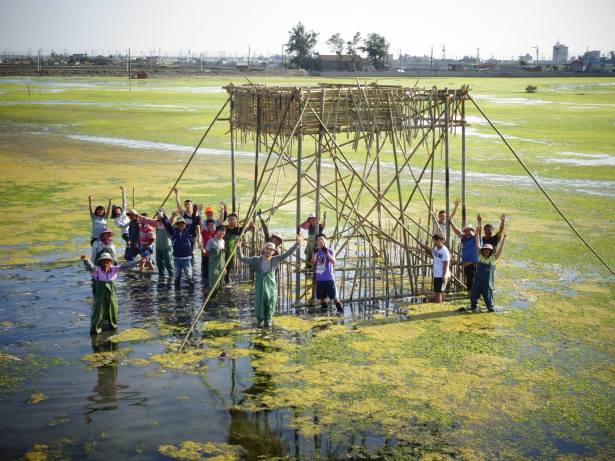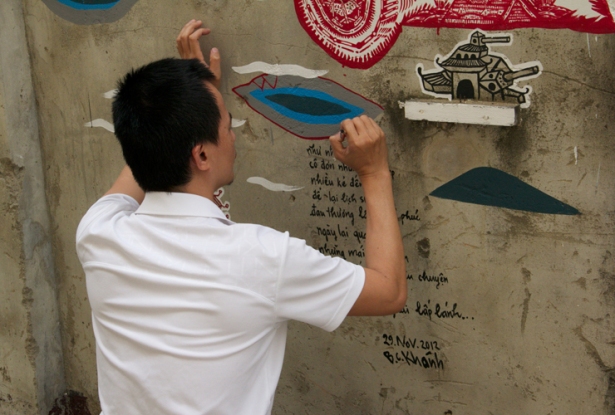This post comes from the Artists and Climate Change Blog
Taiwan, the mountainous island off the southeastern coast of China, is officially known as the Republic of China (ROC). It was given the name Formosa by the Portuguese in the 16th century based on the expression Ilha Formosa, meaning “beautiful island.†And it still lives up to its name. With its subtropical North and a hot, tropical South, it is home to a great diversity of flora and fauna, and colorful temples around almost every corner.
Taiwan has been one of the “Four Asian Dragons†since the 1980s: it has undergone rapid industrialization and become advanced in service and capital-intensive manufacturing. Electronic and computer parts are the production cornerstones in Taiwan, while labor-intensive manufacturing, such as garment manufacturing, have moved to cheaper locations like China. Many people still mainly know of Taiwan because of the “Made in Taiwan†label on their t-shirt. Unfortunately, Taiwan’s rapid economic transformation took place without much concern for the environment.
A big environmental challenge in Taiwan is the contamination of soil, water, and air by heavy industries, mostly from the petrochemical sector. Taiwan didn’t start building an environmental protection system until the late 1980s. By that time, artists had started taking initiatives in addressing environmental issues and today, many of them are engaged as activists. Central to their practice is the use of natural materials such as bamboo.
Here are my ten favorite art initiatives in Taiwan that engage with nature in different ways. If you visit, make sure not to miss these gems!

1. Bamboo Curtain Studio
Website:Â bambooculture.com
Founded: 1995
Type: Residency, independent art space
Who for: Artists, writers, curators, policymakers, environmentalists, communities and scientists from across the globe who are keen to engage in social and environmental projects and want to network in Taiwan
Art has the unique power to foster conversation and be a catalyst for change. We believe art can create social change and provide an alternative perspective to understanding the world. With our previous collaborative artists, we could really feel and witness behavior change through the engagement process. Our practice aims to promote cross-cultural exchanges by providing art and cultural workers with a creative environment and assisting them in carrying out their productions.
—Iris Hung, Director

2. Name: Bio-Art.tw
Website:Â bioart.tw
Founded: 2012
Type: Experimental art space
Who for: Biologists, scientists, artists, (bio) hackers
We are part of biodiversity and we can’t even be responsible for our own survival. We can’t “save†other things, species, as we don’t know what they have in mind, what is good for them. Can we say we have a better life? We only have the ability to judge ourselves. A lot of environmentalists are trying to save the earth or some animal. I recently read that less cute looking animals get less research funding. Everyone should be engaged in this conversation, but I think artists can show us how to observe and think, teach us how to have our own opinion.
—Pei-Ying Lin

3. Cheng Long Wetlands Environmental Art Program
Website:Â artproject4wetland.wordpress.com
Founded: 2010
Type: Annual art program, residency
Who for: Artists, environmentalists, locals, craftsmen, children
In the past, villagers were cutting the trees but now they are protecting the forest. The project did work; villagers now think their land is beautiful. Maybe they cannot solve the problem of the land sinking, but they have learned to live with it and still appreciate it. There is so much participation from the villagers now.
—Zhao Mei Wang

4. TAIWAN East Coast land Arts Festival
Website:Â teclandart.tw/en/author/tecart_people/
Founded: 2015
Type: Festival
Who for: Anyone interested in the East Coast of Taiwan and aboriginal culture, artists, locals, environmentalists
On the East Coast, there are a lot of protests as the government is taking all the nuclear waste to Taitung and Orchid Island. There is a huge gap between communities and the government, and the government is often just making secret (illegal) deals when it comes to nuclear waste or development projects. It’s mostly local people and artists who fight against this. They need lawyers as the government currently has 33 development projects planned on the East Coast, mostly in public areas such as beaches. Now there are people fishing there, in the future they might not even be allowed to go there anymore because of the hotels being built. But it’s their resource. With the East Coast Land Arts Festival, I raise awareness about these issues.
—Shu Lun Wu

5. Guandu International Outdoor Sculpture festival
Website:Â gd-park.org.tw/en/festival
Founded: 2005
Type: Festival, nature park
Who for: Everyone young and old who enjoys nature and/or sculpture
It’s our mission to change peoples’ attitude towards nature (…) The park was initially set up because birdwatchers from the Bird Society were noticing the bird population was declining and they suggested to create a conservation area. When the festival opened at the nature park in 2015, it had more than 20.000 visitors. Even though we don’t have art backgrounds, we are keen to learn more, about land art for instance. However, our starting point is nature and an artists’ starting point will be the arts. But the artwork here will always be eco-friendly.
—Nelson Chen and Yi-Fen Jan

6. RE-THINK (é‡æ–°æ€è€ƒ)
Website:Â rethinktw.blogspot.tw/
Founded: 2013
Type: RE-THINK is a non-profit campaign which operates with other foundations and organizations to cultivate an environment that inspires people to take action to achieve healthy ecosystems; to teach children the importance of environment friendly practices through education programs; to advocate a single-use, non-biodegradable plastic bag ban; and to raise awareness in communities about coastal preservation, ecosystem protection and water quality.
Who for: Children and adults who want to do something creative and care about the natural environment, or just want to learn about it
Our mission is to educate people through real action. “Environmental protection†can hardly be taught through words, so our job is to guide people to the nature and see the pollution and reality through their own eyes. We’ve all been educated on what “environmental friendly†is, from reuse/reduce/recycle, to the aspects of environmental science. It also has become a cliché and only few people pay attention to it in the real life. So, what we’re doing at RE-THINK is to reverse the image of environmental by recreating its design. We design eye-catching or even humorous posts and let people know environmental issues can be fun, stylish, or interesting.
—Daniel Gruber

7. Outsiders Factory
Website:Â outsidersfactory.web.fc2.com/workers_101.html
Founded: 2012
Type: Platform
Who for: Artists, curators, writers, anthropologists, historians, activists and anyone interested in both contemporary art and South-East Asia
I’m tired with “exchanges†and I am advocating for deeper engagement in Asian art, including looking at art history and art theory. There is no real knowledge of the history. This is a big problem in the region.
—Nobuo Takamori, Curator KMFA, Outsiders Factory

8. Taitung Dawn Artist Village
Website:Â dawnartistvillage.com
Founded: 2012
Type: Dawn Artist Village is a non-profit organization that promotes the arts both locally and internationally through art residencies, exhibitions, workshops, and participating in festivals.
Who for: Artists and anyone interested in aboriginal cultures and the East Coast of Taiwan
Taipei business style sits uncomfortably with the Taitung style. Think of a mall versus a grocery store – you need to have passion of the local, otherwise your initiative will not survive in the long term. In the beginning some people might come, but it will not survive if you can’t feel the area.
—Shu Lun Wu, Founder

9. Taipei Artist Village & Treasure Hill
Website:Â artistvillage.org
Founded: 2010
Type: Artist residency
Who for: Artists, locals

10. TheCube
Website:Â thecubespace.com/en/
Founded: 2010
Type: Gallery, exhibition space, curatorial program
Who for: Artists, curators, students
Currently, the Cube is very much focusing on the Asian region and particularly South-East Asia, for instance with a one-year lecture program on multitudes, social movements in Asia. We are interested in social and political changes and how they influence culture change. In addition, we look at the local and work with local artists who are looking at modern history.
—Amy Cheng
AND ONE EXTRA! You don’t want to miss out on this great arts magazine…

11. White Fungus
Website:Â whitefungus.com/
Founded: 2004
Type: Bilingual arts magazine
Who for: Anyone interested in contemporary art, new music, history and politics
The surface of politics doesn’t explain why we can’t deal with our problems. But artists aren’t doing a better job. Being an artist comes with a very narrow range of career opportunities decided by a very small group of people. The oil and tobacco companies are also involved. We all deserve to work hard and be rewarded and we all want a future. When you don’t buy into the illusion, it’s not looking good for you. Also, it depends on luck. If we were working class or peasants, we wouldn’t have the luxury to make a magazine.
—Ron Hanson
______________________________
Curator Yasmine Ostendorf (MA) has worked extensively on international cultural mobility programs and on the topic of art and environment for expert organizations such as Julie’s Bicycle (UK), Bamboo Curtain Studio (TW) Cape Farewell (UK) and Trans Artists (NL). She founded the Green Art Lab Alliance, a network of 35 cultural organizations in Europe and Asia that addresses our social and environmental responsibility, and is the author of the series of guides “Creative Responses to Sustainability.†She is the Head of Nature Research at the Van Eyck Academy (NL), a lab that enables artists to consider nature in relation to ecological and landscape development issues.
Artists and Climate Change is a blog that tracks artistic responses from all disciplines to the problem of climate change. It is both a study about what is being done, and a resource for anyone interested in the subject. Art has the power to reframe the conversation about our environmental crisis so it is inclusive, constructive, and conducive to action. Art can, and should, shape our values and behavior so we are better equipped to face the formidable challenge in front of us.


